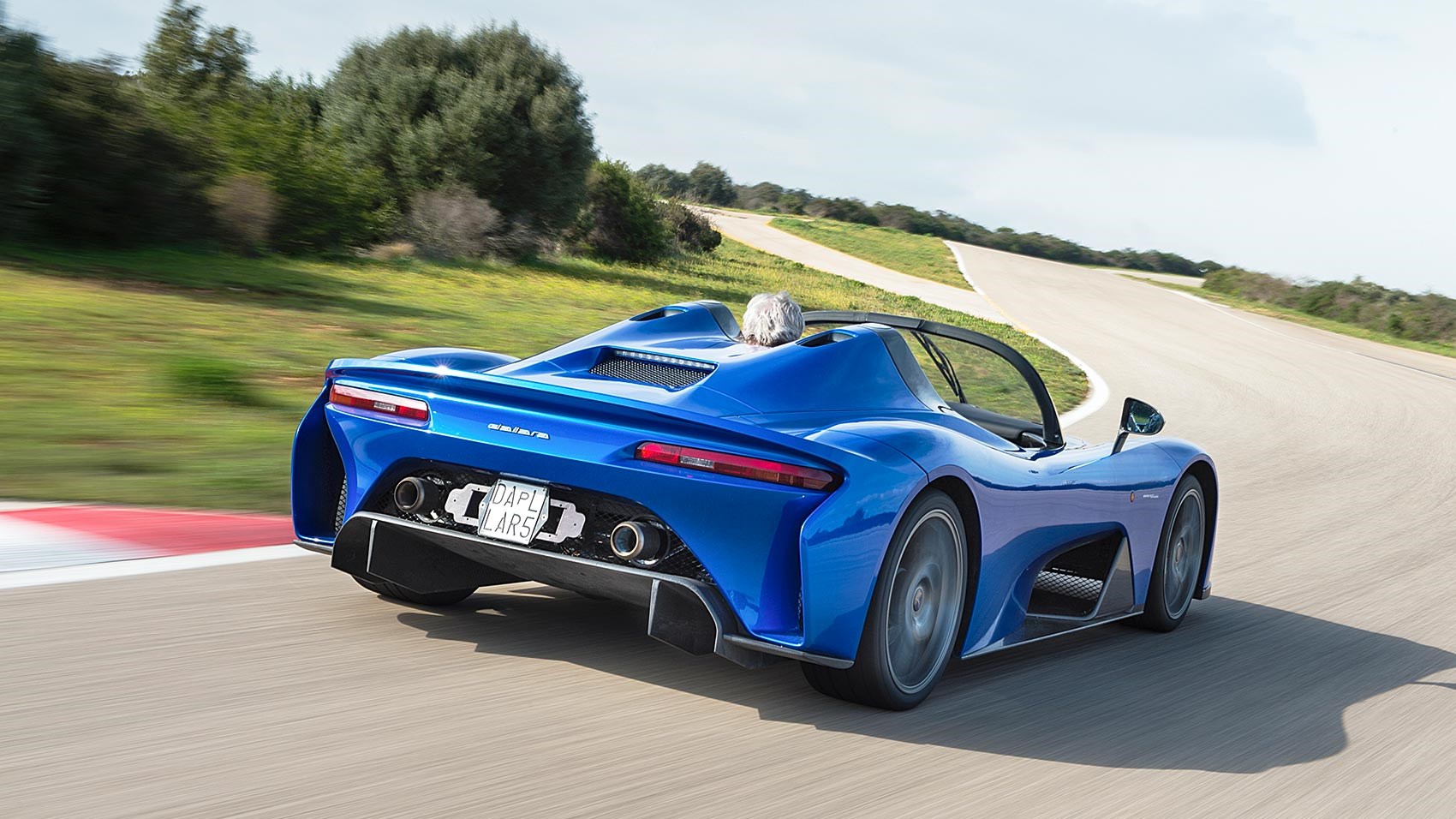► We drive the Dallara Stradale
► Ultimate track-day weapon?
► Review, specs, prices and verdict
Dallara builds race cars for a living. So it won’t come as much of a surprise to learn that the marque’s first road car feels like one. Across the start-finish line, flat-out in third gear, the two-seater is present but for a moment and then gone, trailing a bellowing burble sequentially interrupted by two more upshifts (a manual ’box is standard, the sequential optional). Pushing the Stradale to the limit is an experience that ravages every sense – even with the optional windscreen in place, your helmet still sticks out into the storm like a throbbing carbonfibre lighthouse, the car declaring war on your neck and shoulders with the forces it can summon.
We’re at the Nardo handling track, former F1 man Marco Apicella next to me. Into turn one, 160mph in fifth. ‘Turrrn in, but don’t lift. Now!’ yells Apicella. Keeping the pedal planted goes against your every grain, but all the car does is change direction and stay firmly, spookily, put.
‘Thrrree, two, one. Now!’ We’re dancing the line between braking late and braking too late. I’m certain disaster will strike but no – the balding man with the bull’s neck crouched low in the passenger seat is already talking me through turns two and three in his cool, crackling voice. ‘Brrravissimo! Next time you go a little fasta.’
Our guide to the best track-day cars
So the Dallara doesn’t play by conventional rules, but then neither is it a conventional car. By hopping in you leave behind drop-top sports car conventions; heated seats, air scarves, wind deflectors. Although a comfort pack, complete with gullwing T-top glass canopy, single-arm wiper and air-con is available for a hefty £28,000, most owners will opt for the go-faster options; race roll hoops, the performance kit that removes the catalyst for another 15bhp, the race exhaust and the lowered suspension.

Like a hardcore competition car, the Dallara sets out to erase the chip in your head and re-write it. It does so by cornering substantially faster, braking quantifiably later and plotting its course with more tenacity than almost all previous four-wheeled flings. But you have to build up to it. Because it takes time to grasp the fact that, at the end of the long straight, when the car is travelling at 80% of its top speed, it’s generating 400kg of downforce. This massive ground effect gives awesome lateral grip and directional stability.
Apicella is chortling as I massage my aching neck and shoulders. ‘The Dallara can pull in excess of 2g,’ he smiles. ‘That’s not quite fighter pilot stuff, but it virtually eclipses every other street-legal supercar. Now you know why pros spend so much time in the gym…’
For decades, Dallara has been processing carbonfibre like other makes have shaped steel or aluminium. Thanks to this track-tested lightweight construction technique, the data sheet lists a dry weight of 855 kilos.

The low-tech engine marks a stark contrast to the high-tech composite chassis. After talking to numerous potential suppliers, the Italians opted for the single-turbo 400bhp 2.3-litre Ford Ecoboost four-cylinder, known as the Cleveland engine because that’s where Ford builds it. Delivering peak power at 6200rpm, the mid-mounted 16-valver fuses shirt-sleeved running characteristics with coarse working noises.
Throttle response is brisk but not Ferrari-instant; turbo lag can be an issue when low revs meet a tall gear, and it’s not the keenest to rev. The wrong motor for such an uncompromising driving machine? Not really, because of the torque: 369lb ft from 3000rpm to 5000rpm, thereby defining a broad sweet spot which, in turn, defines the unexpectedly relaxed personality of the Stradale.
The Dallara is, in other words, not only an object lesson in featherweight engineering and aerodynamic excellence, it also musters enough punch to fly high without frantically flapping its wings all the time. On the open road in particular, the two-seater is thus as compelling a GT as it is a blacktop-peeling crackerjack.
On most sections of the track, la macchina arrabiata begs to follow a different line and use a different gear than the best of the rest. With that mighty torque, there’s no need to ever shift down into second. The Stradale creates massive forward motion effortlessly, seamlessly, relentlessly.

After the torque (and the speed and downforce…), the second thing that hits you is the steering. The Dallara does without power assistance or any kind of trickery. Instead its steering is precise, quick and communicative, relaying exactly the right amount of feedback, self-centering moment and effort. It befriends the driver, is a wonderfully haptic interface, and puts control and confidence into your palms.
If you must ask the question then the answer is yes: this steering beats anything and everything that is out there, and it doesn’t employ torque vectoring or rear-wheel steering to do so. It also fits with Dallara’s reductive approach, which waives carbon-ceramic brakes, active anti-roll bars and dynamic drivetrain mounts. Also conspicuous by their absence are nav, music, any type of driver assistance system and, sadly, adaptive LED headlights. Says Apicella, grinning broadly: ‘You don’t drive this car much at night. Think of the insects…’
Dallara plans to build 650 vehicles over five years. With close to 100 units already spoken for, the waiting list currently stretches into 2020. The naked barchetta retails at £166,000. So it’s this or 570S McLaren? ‘No – you own our car in addition to a Ferrari, a Pagani or a Lamborghini,’ says Giampaolo Dallara. ‘Because our car is quite different. We build an analogue, no-frills street-legal racer.’ Indeed he does.
More reviews by CAR magazine